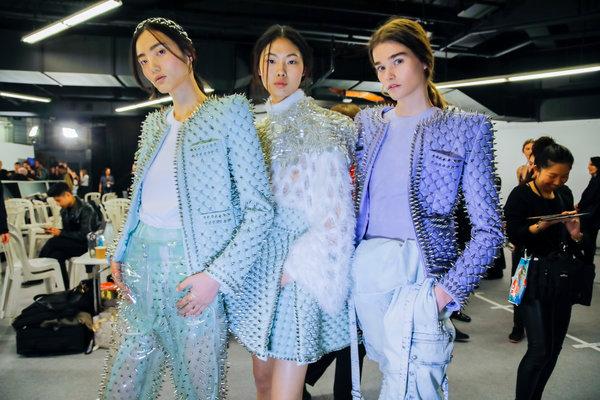PARIS — Deep in the concrete bowels of the Palais de Tokyo, the modern art museum of Paris, down a plunging staircase with walls covered in angry graffiti, amid racks of clothes and roaming models (some of whom were sporting little horns jutting from their foreheads, or with flattened noses), the designer Rick Owens pshawed about current events and the state of the world.
“I’m tired of thinking about doom and decline,” he said.
At the end of a week in which the denuclearization of North Korea did not happen and a soap opera of testimony in Washington, D.C. did, you kind of know what he’s talking about. In any case, he was thinking about something else: glamour, the kind you earn, not the kind that comes with entitlement. It appears to be making something of a comeback.

Balmain, fall 2019CreditValerio Mezzanotti for The New York Times
And that got him thinking about Cecil B. DeMille in the 1930s and Larry LeGaspi, the man who created the style of Kiss in the 1970s — and whose work deeply influenced Mr. Owens (he has a book on the designer coming out later this year). Also Charles James, the couturier, and the lush fabrics and prints of Mario Fortuny.
So he decided to tell an epic story of his own.
He did it in sharp, tailored coats over layers of snap-crotch maillots — “sex where the woman is in control,” he said — and jackets with curving, raised-seam shoulders in silver cowhide or shearling, like folded angel wings. In jersey dresses draped in increasingly complex twists and peekaboo turns around the body, trailing like the traces of ball gowns past onto the floor, and columns of red and fuchsia. He did it with body modification as a reminder of the right to self-definition, and with a supple dignity.
There’s been a lot of protective clothing around this season, a lot of battering-ram shoulders and storm trooper boots and swaddling duvets for when you just can’t take it any more.
At Balmain, Olivier Rousteing added spikes to Easter egg bouclés and stiff princess skirts (hug, and you risk impalement), crunched biker patent leather into thigh-high nail-spiked boots and flowing capes, and otherwise decorated dangerously in a 1980s remix of plastic-covered denim and sheer Swiss-dot blouson jumpsuits and extreme encrustation. He has no fear of the overblown.
But the most evocative clothes are waging a battle of a different kind: one for the values of the silver screen over reality television; for the work of history over the blink-and-you’ll-miss-it reaction to whatever just arrived in your feed; for temptation that comes with a moral center. In the melee, streetwear, the flavor of the most recent moment, is falling by the wayside.
Mr. Owens is not the only one who believes it is time to move on.
At Paco Rabanne, Julien Dossena broke the bonds of 1960s futurism in a terrific Jean Harlow-meets-Jimi Hendrix hybrid of duchess satin-swagged cocktail dresses, silver chain mail bias slips; Art Deco peacock-print rock star suiting and leopard spots. Backstage, his face lit up as he described watching old Audrey Hepburn movies and Marilyn Monroe in “Gentlemen Prefer Blondes,” and buying his own first real piece of fashion (a pair of Raf Simons trousers) and how with that, confidence came.
At Y/Project, Glenn Martens laid thin strips of vinyl over sheaths to create slithers of shine, looped faux fur-lined military skirts up and around, and raised the panniers of Versailles from hips to shoulders, so silk gowns became tents swaying around the body.
And at Loewe, Jonathan Anderson offered an elegantly pointed meditation on the selfie and 16th- and 17th-century cameos (the connection between the two), juxtaposing the now-and-then by setting the cool of a black riding coat against the frippery of handkerchief-hem skirts trimmed in Elizabethan lace; needle punching ribbed cream knits into organdy petticoats; and flopping a cravat and balloon sleeves out from under a basic black knit tank. The details mattered.
Tweed capes were trimmed in falls of feathers, and a jacket was nipped in at the waist and pinched in back — almost as if grabbed by a hand, to flare over the hips. A pearl-encrusted sweater was paired with a giant jeans (big pants are a trend). There were some bouncing, big yarn pompoms and winged skull caps with a beanie top, drawing a thin line from the court of Mary, Queen of Scots to the court of the influencer. The current convulsive instant may pass but not so much the human condition.
There is a depth and emotional connection in these clothes that just doesn’t exist in Virgil Abloh’s Off-White, though even Mr. Abloh — he of the ironic quotes and collaborator cool — was toying with the old razzle-dazzle: showing a sleeping-bag-size silver puffer over a Lurex silver union suit, followed by a silver satin jacket and shorts, followed by a silver satin evening coat.
They stood out amid the racecar checks and leather sweats, the oversize faded denim painter’s pants and utilitarian body-con knits dangling — well, it wasn’t clear what they were; straps? But Mr. Abloh’s reference points seem to have more to do with his peer group than any larger idea. At the end, a troika of billowing, beachy ball gowns appeared, slit to the thigh and worn over micro shorts.
Maybe they were supposed to lighten things up. Begone, ye political and ecological angst! The problem is that they looked, like the material they were made from and the whole collection itself, awfully unconvincing.







